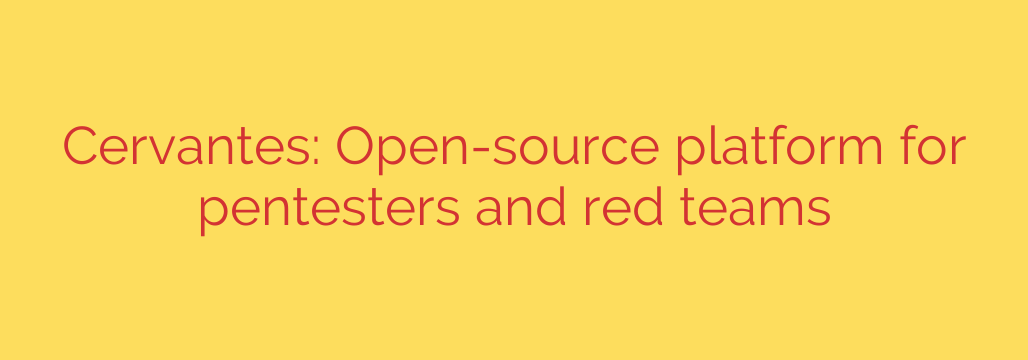
Cervantes: The Open-Source Command Center for Modern Pentesters and Red Teams
Every penetration tester and red team operator knows the chaos. Your screen is a mosaic of terminal windows, note-taking apps, and screenshot folders. Data from Nmap, Burp Suite, and custom scripts are scattered across different files. Collaborating with teammates involves a frantic exchange of messages and files, hoping nothing gets lost in translation. When it’s time to write the final report, the real headache begins: piecing together fragmented evidence into a coherent, professional document.
What if there was a better way? A centralized command center designed specifically for the complex workflow of offensive security engagements. This is the solution offered by Cervantes, a powerful, open-source platform built to streamline every phase of a security assessment.
Taming the Chaos: The Core Challenge in Offensive Security
Modern security testing generates a massive amount of data. Without a unified system, teams face significant hurdles that can impact the quality and efficiency of their work:
- Data Fragmentation: Findings, notes, commands, and evidence are stored in disparate locations, making it difficult to get a holistic view of the project.
- Collaboration Breakdowns: Multiple operators working on the same engagement struggle to share findings in real-time, leading to duplicated efforts and missed opportunities.
- Reporting Bottlenecks: Compiling a comprehensive report is a manual, time-consuming process that takes valuable time away from actual testing.
- Lack of Standardization: Different team members may use different methods for tracking vulnerabilities, leading to inconsistencies across projects.
What is Cervantes? A Centralized Hub for Security Projects
Cervantes is an open-source, self-hostable platform designed to act as a central repository for all activities related to a security engagement. Think of it as a project management tool, a vulnerability database, and a collaboration hub all rolled into one, tailored specifically for the needs of offensive security professionals.
By providing a single source of truth, Cervantes allows teams to manage clients, projects, tasks, and vulnerabilities from a unified dashboard. This structured approach ensures that all data is organized, accessible, and consistent throughout the engagement lifecycle.
Key Features That Empower Security Teams
The power of Cervantes lies in its thoughtful design, which directly addresses the pain points of pentesters and red teams.
Centralized Data Management: No more scattered notes or lost evidence. Cervantes provides a structured database to store every piece of information, from initial reconnaissance findings to detailed vulnerability descriptions and proof-of-concept code. All data is linked to a specific project and client for easy tracking.
Real-Time Collaboration: The platform is built for teamwork. Multiple users can work on the same project simultaneously, with visibility into each other’s findings. This ensures everyone is on the same page, preventing redundant work and fostering a more integrated team effort.
Streamlined Vulnerability Tracking: Cervantes excels at issue management. You can create detailed entries for each vulnerability, assigning it a severity score (e.g., CVSS), tracking its status (Open, Closed, In Progress), and linking all associated evidence. This creates an auditable trail for every finding, from discovery to remediation.
Simplified Reporting: Perhaps one of its most valuable features is the ability to generate professional reports with ease. Because all the data is already organized within the platform, you can quickly compile findings into customizable report templates, saving countless hours of manual formatting and data entry.
Open-Source and Self-Hosted: As an open-source tool, Cervantes offers complete transparency and flexibility. You can audit the code, customize it to fit your team’s specific needs, and integrate it with other tools in your arsenal. Being self-hosted also means you retain full control over your sensitive client data, a critical security consideration.
Best Practices for Implementing a Centralized Pentesting Platform
Adopting a tool like Cervantes can transform your workflow, but success depends on proper implementation. Here are a few actionable tips:
Standardize Your Workflow: Before diving in, your team should agree on a standardized process. Define naming conventions for projects, establish clear guidelines for documenting vulnerabilities, and decide on a consistent method for uploading evidence. This ensures consistency across all engagements.
Prioritize Data Security: Since you are hosting the platform yourself, securing the Cervantes instance is your responsibility. Ensure it is deployed on a hardened server, protected by a firewall, and that access controls are strictly enforced. Regularly back up your data to prevent loss.
Integrate and Automate: Leverage the open-source nature of Cervantes to connect it with your existing toolchain. You can explore creating scripts to automatically import scan results from tools like Nmap or Nessus directly into a project, further reducing manual effort.
Why Cervantes is a Game-Changer for Offensive Security
In a field where efficiency and accuracy are paramount, working with scattered, disorganized data is no longer viable. Tools like Cervantes represent a major step forward, enabling teams to operate more like a cohesive unit rather than a collection of individuals.
By centralizing data, simplifying collaboration, and streamlining the reporting process, Cervantes empowers pentesters and red teams to focus on what they do best: finding and exploiting vulnerabilities. It helps deliver higher-quality results to clients and builds a scalable, repeatable process for future engagements, making it an essential addition to any modern security team’s toolkit.
Source: https://www.helpnetsecurity.com/2025/07/23/cervantes-open-source-collaborative-platform-pentesters-red-teams/








